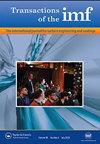研究了304不锈钢在无Cr6+的硫酸溶液中a.v钝化形成彩色钝化膜的生长机理
IF 1.5
4区 材料科学
Q4 ELECTROCHEMISTRY
Transactions of The Institute of Metal Finishing
Pub Date : 1999-01-01
DOI:10.1080/00202967.1999.11871260
引用次数: 8
摘要
在不含铬6+的硫酸溶液中,采用交变方波极化,在304不锈钢表面获得了具有干涉色的钝化膜。用XPS对膜的化学组成和价态分布进行了研究。提出了着色过程的机理。本文章由计算机程序翻译,如有差异,请以英文原文为准。
The growth mechanism of the coloured passive film formed on 304 stainless steel in sulfuric solution without Cr6+ ion by using A.V. passivation
A thick passive film showing interference colours has been obtained on 304 stainless steel in sulfuric acid solution without Cr 6+ ions by applying alternating square wave polarization. An investigation of the chemical composition and the distribution of valence states in the profile of the film has been carried out by using XPS. A mechanism for the colouring process is proposed.
求助全文
通过发布文献求助,成功后即可免费获取论文全文。
去求助
来源期刊

Transactions of The Institute of Metal Finishing
工程技术-材料科学:膜
CiteScore
3.40
自引率
10.50%
发文量
62
审稿时长
3 months
期刊介绍:
Transactions of the Institute of Metal Finishing provides international peer-reviewed coverage of all aspects of surface finishing and surface engineering, from fundamental research to in-service applications. The coverage is principally concerned with the application of surface engineering and coating technologies to enhance the properties of engineering components and assemblies. These techniques include electroplating and electroless plating and their pre- and post-treatments, thus embracing all cleaning pickling and chemical conversion processes, and also complementary processes such as anodising. Increasingly, other processes are becoming important particularly regarding surface profile, texture, opacity, contact integrity, etc.
 求助内容:
求助内容: 应助结果提醒方式:
应助结果提醒方式:


